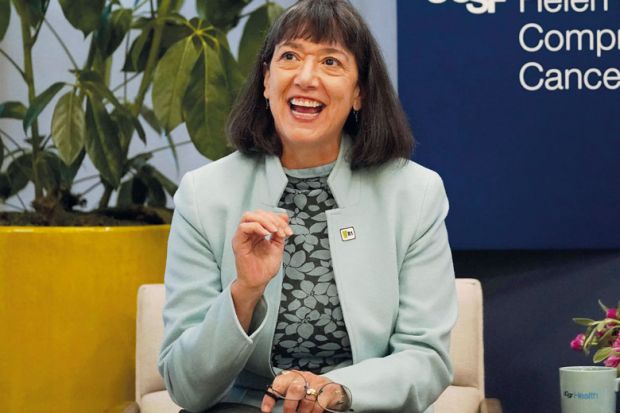The US National Institutes of Health’s new leader is telling researchers to expect an NIH that is much more focused on proposals that are collaborative and illuminate a pathway towards needed societal change.
Fundamental science remains “the underpinning of everything we do”, said Monica Bertagnolli, a former professor of surgery at Harvard University. “But we need to see the results of fundamental science be fully translated to achieve societal benefit,” Dr Bertagnolli said in an interview with Times Higher Education.
Dr Bertagnolli took over the NIH leadership in November, after more than a year of heading its largest division, the National Cancer Institute. The NIH is the world’s largest public funder of biomedical science, and she is its first permanent director since the record-setting 12-year tenure of Francis Collins.
The NIH has long touted its mission to spend its federal investment – now about $47 billion (£37 billion) a year – on studying the causes and treatments of human diseases, though not necessarily their prevention.
Dr Bertagnolli, in outlining her ambitions as director, has talked of seeking an expansive understanding of that mission. In a briefing with reporters shortly after taking office, she promised that the NIH would work hard to ensure greater diversity among the participants in the medical trials it runs and funds.
Speaking to THE, she put a heavy emphasis on building collaborations across academic fields and paying attention to communities – the people affected by a disease or other health condition – while acknowledging the critical challenge of defining exactly what boundary lines of action that could mean.
The director cited examples such as sickle cell disease, where scientists recently made a stunning breakthrough for treating the extremely debilitating condition affecting populations of African descent, only to have that therapy be so expensive – millions of dollars per person – that its actual availability may be tragically limited.
And as a cancer researcher, Dr Bertagnolli acknowledged seeing remarkable gains in cures for cancers, only to then watch fast-rising patient caseloads due to causes that evade understanding or implementation, mainly because of political and social challenges in such areas as poverty and racism.
Within its mission, she said, the NIH can do far more to research those connections and their communities, “to study exactly what components of poverty are at play, and how different ways of tackling that issue can have an effect on overall health”.
But the agency and its grant recipients can only point out and explain and quantify those deadly “social determinants of health”, she said. It must then hope that others take the necessary action to address them, she said.
“We’re not here to make health policy – that’s not our job,” Dr Bertagnolli said. “However, we definitely are here to bring the data that allows those who are responsible for health policy to make the very best decisions and then apply those policies well, and where needed to make new policies.”
In stepping down from the longest term as a presidentially appointed director of the NIH, Dr Collins said that one of his biggest regrets was the persistence of a significant race-based inequity in the NIH’s grant distribution.
Dr Bertagnolli said she shares that concern and is hopeful that a newly established NIH policy – it is continuing to use grant review panels composed of academic scientists, but giving more final authority over awards to NIH staff – will soon start making a noticeable difference in both racial and gender equity.
“We’re looking to see that maybe take away a little bit of the reputational bump that some individuals get,” she said.
The NIH is doing much better with regard to gender, Dr Bertagnolli noted, with women now heading the NIH and two of its largest institutes.
Women also fare as well as men when applying for the main category of NIH research grants, she said, though with fewer women and minorities actually trying. The shift in the grant review process towards staff-driven decisions will hopefully help there as well, by encouraging a wider range of applicants, she said.
“We still do believe in peer review, certainly,” Dr Bertagnolli said. “We just want to make the peer review process as fair and equitable as possible, and this is a new step to achieve that.”
Register to continue
Why register?
- Registration is free and only takes a moment
- Once registered, you can read 3 articles a month
- Sign up for our newsletter
Subscribe
Or subscribe for unlimited access to:
- Unlimited access to news, views, insights & reviews
- Digital editions
- Digital access to THE’s university and college rankings analysis
Already registered or a current subscriber? Login








